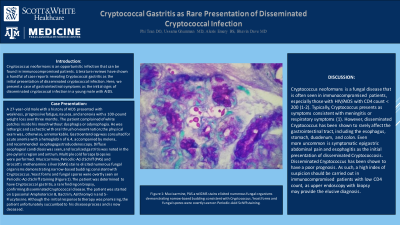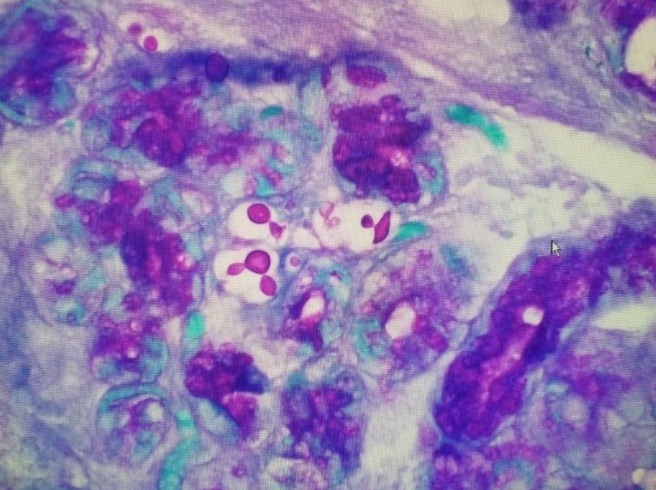Sunday Poster Session
Category: Stomach
P1362 - Cryptococcal Gastritis as Rare Presentation of Disseminated Cryptococcal Infection
Sunday, October 22, 2023
3:30 PM - 7:00 PM PT
Location: Exhibit Hall

Has Audio

Phi P. Tran, DO
Baylor Scott & White
Temple, TX
Presenting Author(s)
Phi P. Tran, DO1, Ussama Ghumman, MD2, Alexis Emery, BS1, Bhavin Dave, MD2
1Baylor Scott & White, Temple, TX; 2Bayhealth Medical Center, Dover, DE
Introduction: Cryptococcus neoformans is an opportunistic infection that can be found in immunocompromised patients. Literature reviews have shown a handful of case reports revealing Cryptococcal gastritis as the initial presentation of disseminated cryptococcal infection. Here, we present a case of gastrointestinal symptoms as the initial signs of disseminated cryptococcal infection in a young male with AIDS.
Case Description/Methods: A 27-year-old male with a history of AIDS presented with weakness, progressive fatigue, nausea, and anorexia with a 100-pound weight loss over three months. The patient complained of white patches inside his mouth without dysphagia or odynophagia. He was lethargic and cachectic with oral thrush on examination; the physical exam was, otherwise, unremarkable. Gastroenterology was consulted for acute anemia with a hemoglobin of 6.4, accompanied by melena, and recommended esophagogastroduodenoscopy. Diffuse esophageal candidiasis was seen, and localized gastritis was noted in the pre-pyloric region and antrum. Multiple cold forceps biopsies were performed. Mucicarmine, Periodic-Acid Schiff (PAS) and Grocott's methenamine silver (GMS) stains elicited numerous fungal organisms demonstrating narrow-based budding: consistent with Cryptococcus. Yeast forms and fungal spores were overtly seen on Periodic-Acid Schiff staining (Figure 1). The patient was determined to have Cryptococcal gastritis, a rare finding on biopsy, confirming disseminated Cryptococcal disease. The patient was started on Liposomal Amphotericin B, Bactrim, Azithromycin and 5-Flucytosine. Although the initial response to therapy was promising, the patient unfortunately succumbed to his disease process and is now deceased.
Discussion: Cryptococcus neoformans is a fungal disease that is often seen in immunocompromised patients, especially those with HIV/AIDS with CD4 count < 200 (1-2). Typically, Cryptococcus presents as symptoms consistent with meningitis or respiratory symptoms (1). However, disseminated Cryptococcus has been shown to rarely affect the gastrointestinal tract, including the esophagus, stomach, duodenum, and colon. Even more uncommon is symptomatic epigastric abdominal pain and esophagitis as the initial presentation of disseminated Cryptococcosis. Disseminated Cryptococcus has been shown to have a poor prognosis. As such, a high index of suspicion should be carried out in immunocompromised patients with low CD4 count, as upper endoscopy with biopsy may provide the elusive diagnosis.

Disclosures:
Phi P. Tran, DO1, Ussama Ghumman, MD2, Alexis Emery, BS1, Bhavin Dave, MD2. P1362 - Cryptococcal Gastritis as Rare Presentation of Disseminated Cryptococcal Infection, ACG 2023 Annual Scientific Meeting Abstracts. Vancouver, BC, Canada: American College of Gastroenterology.
1Baylor Scott & White, Temple, TX; 2Bayhealth Medical Center, Dover, DE
Introduction: Cryptococcus neoformans is an opportunistic infection that can be found in immunocompromised patients. Literature reviews have shown a handful of case reports revealing Cryptococcal gastritis as the initial presentation of disseminated cryptococcal infection. Here, we present a case of gastrointestinal symptoms as the initial signs of disseminated cryptococcal infection in a young male with AIDS.
Case Description/Methods: A 27-year-old male with a history of AIDS presented with weakness, progressive fatigue, nausea, and anorexia with a 100-pound weight loss over three months. The patient complained of white patches inside his mouth without dysphagia or odynophagia. He was lethargic and cachectic with oral thrush on examination; the physical exam was, otherwise, unremarkable. Gastroenterology was consulted for acute anemia with a hemoglobin of 6.4, accompanied by melena, and recommended esophagogastroduodenoscopy. Diffuse esophageal candidiasis was seen, and localized gastritis was noted in the pre-pyloric region and antrum. Multiple cold forceps biopsies were performed. Mucicarmine, Periodic-Acid Schiff (PAS) and Grocott's methenamine silver (GMS) stains elicited numerous fungal organisms demonstrating narrow-based budding: consistent with Cryptococcus. Yeast forms and fungal spores were overtly seen on Periodic-Acid Schiff staining (Figure 1). The patient was determined to have Cryptococcal gastritis, a rare finding on biopsy, confirming disseminated Cryptococcal disease. The patient was started on Liposomal Amphotericin B, Bactrim, Azithromycin and 5-Flucytosine. Although the initial response to therapy was promising, the patient unfortunately succumbed to his disease process and is now deceased.
Discussion: Cryptococcus neoformans is a fungal disease that is often seen in immunocompromised patients, especially those with HIV/AIDS with CD4 count < 200 (1-2). Typically, Cryptococcus presents as symptoms consistent with meningitis or respiratory symptoms (1). However, disseminated Cryptococcus has been shown to rarely affect the gastrointestinal tract, including the esophagus, stomach, duodenum, and colon. Even more uncommon is symptomatic epigastric abdominal pain and esophagitis as the initial presentation of disseminated Cryptococcosis. Disseminated Cryptococcus has been shown to have a poor prognosis. As such, a high index of suspicion should be carried out in immunocompromised patients with low CD4 count, as upper endoscopy with biopsy may provide the elusive diagnosis.

Figure: Mucicarmine, PAS and GMS stains elicited numerous fungal organisms demonstrating narrow-based budding: consistent with Cryptococcus. Yeast forms and fungal spores were overtly seen on Periodic-Acid Schiff staining.
Disclosures:
Phi Tran indicated no relevant financial relationships.
Ussama Ghumman indicated no relevant financial relationships.
Alexis Emery indicated no relevant financial relationships.
Bhavin Dave indicated no relevant financial relationships.
Phi P. Tran, DO1, Ussama Ghumman, MD2, Alexis Emery, BS1, Bhavin Dave, MD2. P1362 - Cryptococcal Gastritis as Rare Presentation of Disseminated Cryptococcal Infection, ACG 2023 Annual Scientific Meeting Abstracts. Vancouver, BC, Canada: American College of Gastroenterology.
